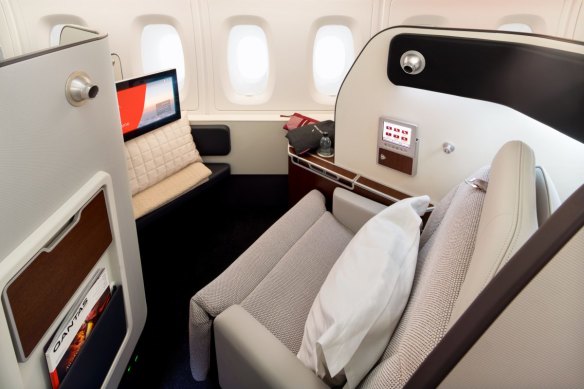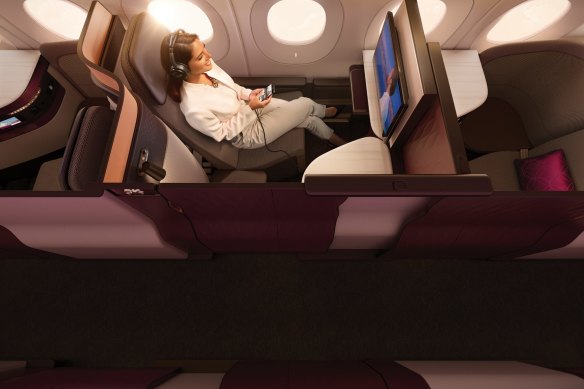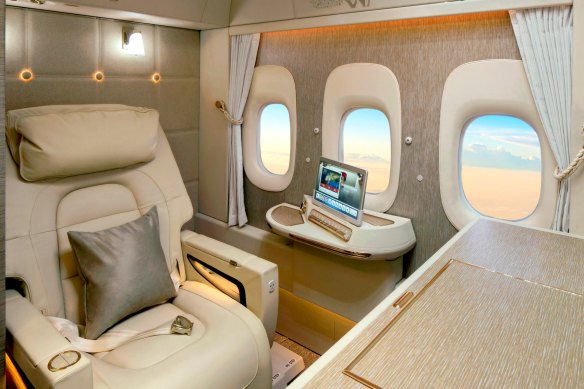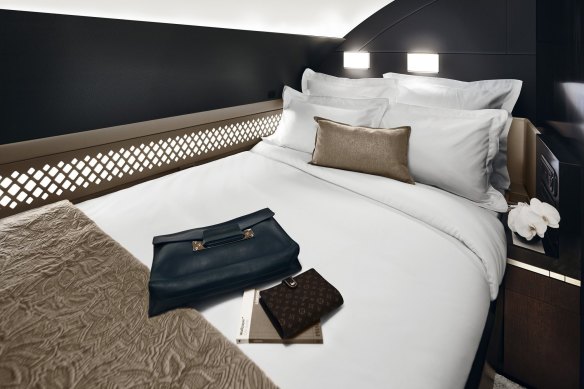This was published 1 year ago
Opinion
Airlines are scrapping first class, but it’s not dead just yet
Michael Gebicki
The TripologistIs first-class air travel going to disappear? Like traveller’s cheques, departure cards, baggage without wheels? You might think so from the way some of the world’s leading airlines are shedding the class.
Air New Zealand, Malaysian Airlines, South African Airways, Asiana Airlines, Turkish Airlines and LATAM are just some that no longer offer the highest level of airline travel. Qantas offers first class only aboard its Airbus A380 superjumbo flights.

First class on board a Qantas Airbus A380.
In September 2022, American Airlines, the only US airline to still offer first, announced that from late 2024 it would no longer offer the class on international flights. Chief commercial officer Vasu Raja blamed a decline in sales of the carrier’s first-class seats, but the seat was never a hot seller with premium-class travellers. It rated well below its competitors, and just a small step up from its business class seats, which hardly justified the additional cost.
Even those airlines that maintain their affection for first class cabins have tended to restrict the routes on which they offer the service to the world’s financial capitals. There’s an exception in the case of the Gulf states, which have significant numbers of passengers prepared to stump up for a first-class seat.
Why it’s happening
The main reason for the decline in the popularity of first class is the ever-improving comfort and sophistication of the business class cabin. When it first appeared in the late 1970s a business class fare got you a seat with about 20 centimetres of extra legroom, express boarding and marginally more edible food than economy passengers.
Since that time, there’s been a slow and steady evolution, with a few giant leaps. One of those leaps happened in 1992 when Continental Airlines mashed its business and first class together to create BusinessFirst, offering 55 inches (140 centimetres) of legroom, a 2-2-2 seat configuration and meals ported from first class menus – and sold those seats at a business-class price. Eight years later, British Airways became the first airline to offer a lie-flat seat in business class, and the writing was on the wall for the first-class cabin.
Since then, leading carriers have plumped up their business class service with fine wines and meals curated by big-name chefs, bigger inflight entertainment screens, priority service, chauffeur transport to and from the airport, and red-carpet treatment from check-in to final destination.
In the see-you-and-raise-you poker game that airlines play in the competition for the lucrative business-flyer trade, the latest trend is doors that turn a business class seat into a private enclave. Or a double bed for two in the case of Qatar’s Q Suite.

Qatar Airways QSuite was the first to put a door on a business class seat.
Japan ANA’s The Room seats, British Airways’ Club Suite and the Delta One Suites aboard the US carrier all come with doors. Those refinements have sucked the oxygen from first class. While a first class seat gives you more space, an upgraded menu and more attentive service, whether you’ve flown first or business does not make much difference in the way you feel at the end of a long-haul flight.
From the airlines’ standpoint, first-class seats are a tough sell. A first class return ticket from Melbourne to London in September with Singapore Airlines will cost about $19,600. Those same flights in business cost just over $14,000. Fly first class return from Sydney to Paris in September with Emirates and you can expect to pay $17,720, and $13,053 in business. Fly Sydney-to-London return with Qantas on a first class ticket and you will pay close to $20,000. A business class seat on those same flights could cost you just under $16,000.

Emirates continues to offer first class to passengers.
Note that in some cases, the price difference between a business and a first class ticket is not great. That has only happened in the aftermath of the pandemic.
In 2017, a first class seat went for almost double the price of a business seat. While airlines are slowly returning to full capacity, business class seats have increased massively in price while the increase in first class air travel has been more gradual.
Even so, the number of travellers prepared to pay for those first-class seats is tiny. The occupant is often a passenger upgraded from business, whose loyalty to the airline is confirmed by a seven-figure points balance.
Another reason for the decline, aircraft fitted with first-class cabins are less flexible. If an aircraft configured with economy and business class seats is taken offline, substituting it with an aircraft with first-class seats is a loss maker for the airline since there’s little demand for those seats.
Does first class have a future?

Etihad’s The Residence offers a separate bedroom with double bed.
It might be shrinking, but no question, first-class has a future, catering to a small but devoted clientele who demand the ultimate in luxury in the skies, and damn the cost. It’s also aspirational for airlines such as Emirates, which like to showcase their lavish service. Qantas will feature first-class suites aboard the A350 aircraft slated for its non-stop flights to London and New York, scheduled to begin in 2025.
Even The Residence, Etihad’s over-the-top luxury cabin suite complete with a bedroom, living room, bathroom and butler, will soon be back in the skies as the airline reboots its four A380s, scheduled to recommence flights between Abu Dhabi and London on July 15, 2023. Expect the price to cause heart palpitations.
Sign up for the Traveller newsletter
The latest travel news, tips and inspiration delivered to your inbox. Sign up now.